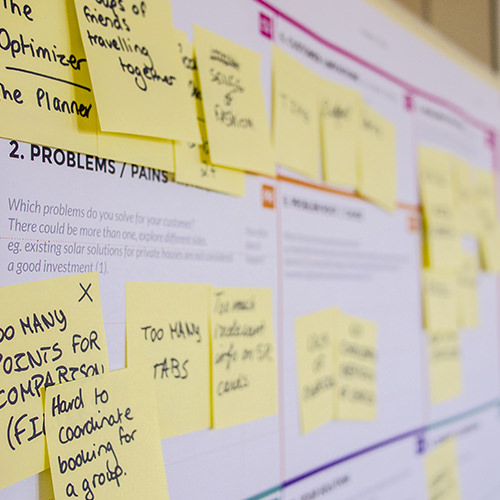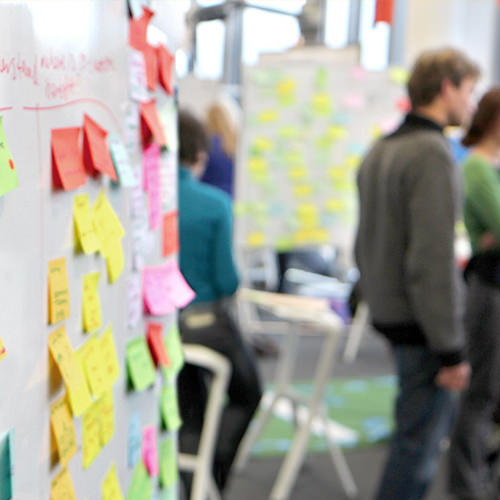Last week, I read the latest of a dozen or so blog posts I’ve come across trashing personas or user interviews or customer journeys or jobs to be done or [insert your design tool or method here]. My immediate reaction to this is frustration and concern.
If you hire a carpenter to build you a table and the finished product doesn’t fit your space, you don’t blame the hammer, you blame the craftsman.
Most of these articles and posts follow a similar pattern. They lead with a very provocative title that implies you should forget everything you know, or that you are doing it all wrong. (And yes, I recognize the irony here.) The author then provides a fairly well-written thesis as to why a certain design tool or method is fundamentally broken or “complete trash”. They provide real-world examples and talk about specific times the tool or method has failed them. Occasionally, they will also provide details on how the tool was crafted and the nature of the content or framework they used. And every time I read these descriptions I have the same reaction… “Of course personas failed them here, that is not how they are supposed to work!”
I’ve had this same debate with my peers many times. I will hear someone say, “I hate personas,” and my immediate response is, “Explain to me why you feel that way.” After all, I am a researcher and I have a responsibility to ask, listen and build empathy for their point of view. The conversation will go back and forth for a while but it inevitably always leads to the same conclusion — they have seen more badly-written personas than good ones. The tool has been so over-used and abused, that it has gotten a bad reputation and they want to distance themselves from it.
This attitude is dangerous. The tools themselves aren’t the problem, it’s how they are being misused. I believe there are four tenets we should keep in mind to prevent us from cutting off our nose to spite our face.
Choose the Right Tool
Just like a master carpenter has saws and hammers and wrenches in his woodshop, designers have a plethora of methods and frameworks at our disposal. Ethnographic research methods, workshops, personas, customer journeys, mind maps, storyboards, sketches, prototypes, etc. are the tools of our trade. Just like a good carpenter, we need to know how and when to use the right tools to get a specific job done.
Not every project requires us to write personas. Interviews (or interviews alone) are not always the best way to collect the insights we need to understand our users. Customer journeys are not the be-all and end-all in visualizing a user’s experience. The tools and methods we use should differ from project to project because the specific goals and scope of each project is different.
“If all you have is a hammer, everything looks like a nail.” - Abraham Maslow
Each tool in our toolbox has a specific purpose and context in which it should be used. Just as the carpenter needs to know when to use a table saw versus a band saw, we need to educate ourselves on when personas are, and are not, appropriate to use and what may be best to use in their place. In order to plan and select the proper tools, we need to ask ourselves the following:
- What do I need to know to be successful? How can I learn that?
- What is the best way to synthesis, visualize and share what I learn so that the key insights and opportunities can be actioned and addressed in design?
- What secondary research methods can complement and further validate these findings?
Use The Tool The Right Way
Selecting the right tool for the job is only half the battle. You also need to know how to use it. If you’ve taken a wood-working class, you will remember that on the first day you likely had safety training. The instructor takes you around to each piece of equipment and shows you the proper way to use it. If your instructor was anything like mine, you also heard stories of people who were maimed because they used the tools incorrectly. While it is unlikely that you will lose a finger if you write a bad persona, the consequences can still be costly.
If I were struggling to use a hammer, because I was holding it backwards, and then loudly declared “all hammers are useless,” my carpenter friends would laugh in my face.
Interviews, observations, diary studies and workshops should be carefully planned and properly executed. We need to ask the right questions in the right way and document consistently to ensure we collect the right data and answer our pre-defined objectives. Our analysis and synthesis should be rigorous. Whether we are conducting a formal study or quick-and-dirty guerilla research we should never be sloppy or we can’t trust the outcomes.
Personas, customer journeys, jobs to be done, user stories, and service blueprints MUST be based on real user data and insights. I once walked into a workshop and observed a group of people writing a persona. I was a little confused at first, but once I realized they were making the entire thing based on what they “thought”, a little piece of me died on the inside. You can’t claim all personas are garbage if you are only using trash to create yours.
The outcomes of your research should be actionable and set a clear direction for design. Personas should contain attitudes, behaviors, motivations, needs and pain points that we can tap into and address. I don’t care that “Henry the Hipster” is a vegan who hangs out at his local cafe and bikes everywhere. I want to know why he chose to be vegan and how that motivation or attitude influences other aspects of his life. Why did he choose that particular cafe? What rational and emotional thoughts affected his reasoning and loyalty? Why is biking his prefered mode of transportation? Maybe he can’t afford a car, maybe he enjoys the physical activity, maybe it’s a matter of sustainability. The answers to these questions can give me the insights I need to design the right thing for Henry.
Balance Consistency With Adaptability
I previously taught a contextual research course for graduate-level designers. When my students were synthesizing their research and creating their design deliverables, I would often be asked to share “templates” for artifacts such as personas or customer journeys. While I understand why they asked the question, I always cringe a bit when it’s suggested we could or should be templatizing a tool like this.
Some of the agencies that I have worked for have strived for consistency in deliverables. An artifact from Shop X, should look like an artifact from Shop X in both branding and format. I have tried to balance this with my own philosophy and approach to the types of tools that I use and the things I make. But just as the tools we use need to differ from project to project, some of their components or format may also need to change.
The personas I write always contain a name, image, quote, short descriptor and narrative or list of beliefs, attitudes and motivations. Depending on the specific goals and needs of the project there are other components to the personas I may swap in or out — pains and gains, 2x2s, semantic differentials, connections to a journey, brand resonance, and device usage to name a few. My advice is to start with a solid definition of your tool, its purpose and core components but don’t be afraid to adapt and adjust the format to fit specific needs or goals. Play with the format until it’s something that works for your team and objective.
Share, Debate, Learn, and Refine
I’ve been working in the design field for over 15 years and I never stop looking for inspiration and ways I can grow, adapt and refine my toolbox. Almost every time I pull out a tool to use, I am making a slight tweak because I learned something the last time I used it or read/saw a technique I’d like to try. I’m fortunate that I have found a community and built a network of peers I can turn to for support, critique and discourse.
Find your tribe, engage with and leverage them. When you have a new problem to solve, ask for advice on new methods or approaches to try. I guarantee, someone in our industry has tackled something similar and has tips on what has or hasn’t worked for them. We know our tool set needs to be adjusted based on context. Test and learn what will work, when, where and how. Find opportunities where you can explore methods and give yourself freedom to fail. Learn from your failures and refine your approach. It’s important that we have outlets for informed, healthy debate on topics such as this in order to continue to grow and evolve as designers.
Every tool has a purpose but learning how and when to apply those tools is just as important. Remember that methodology matters.
This article was first published on May 25, 2018, 2018 on Medium. You can read the original article by clicking here.


